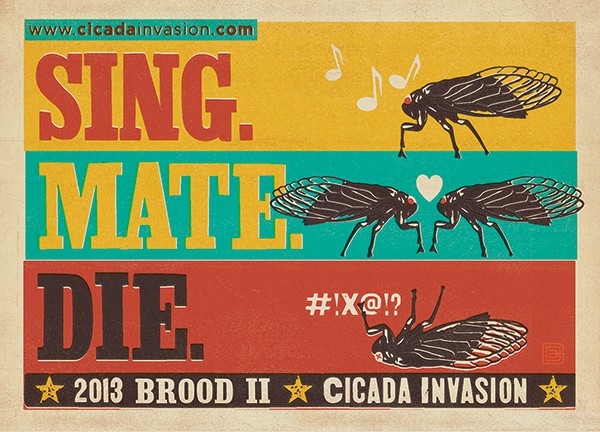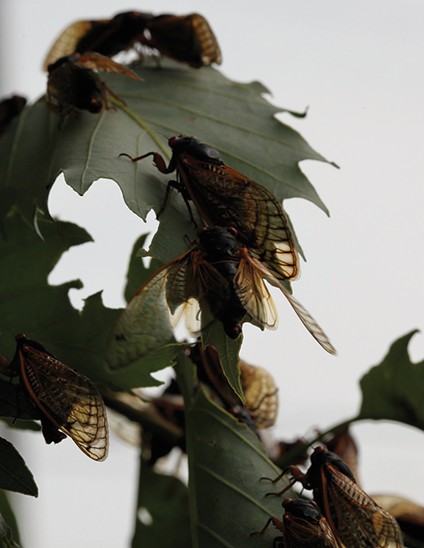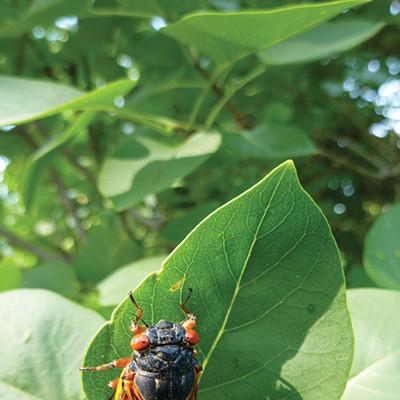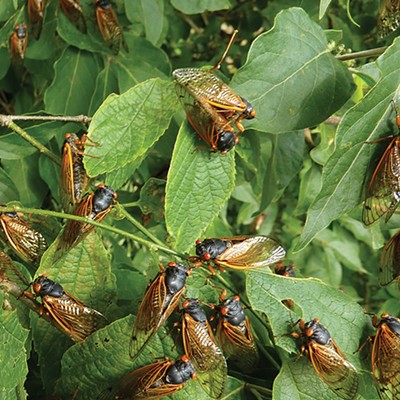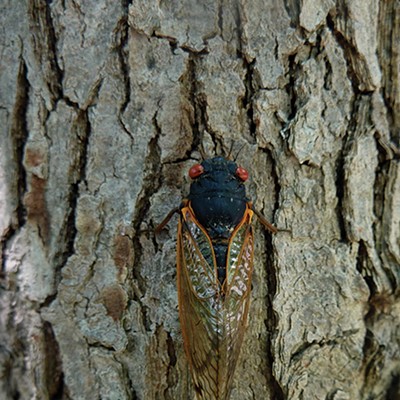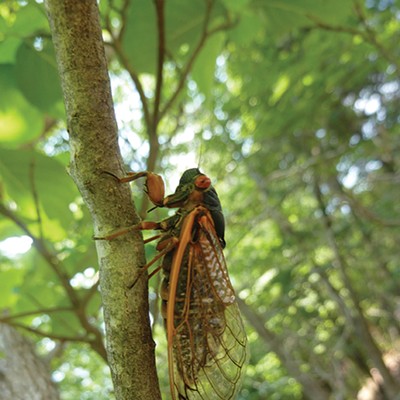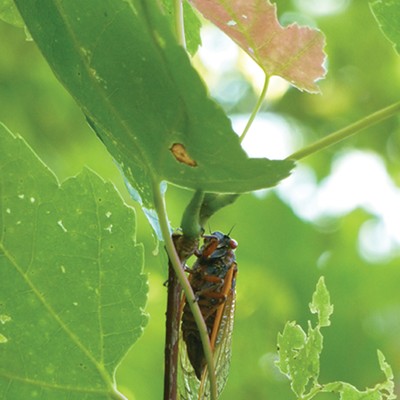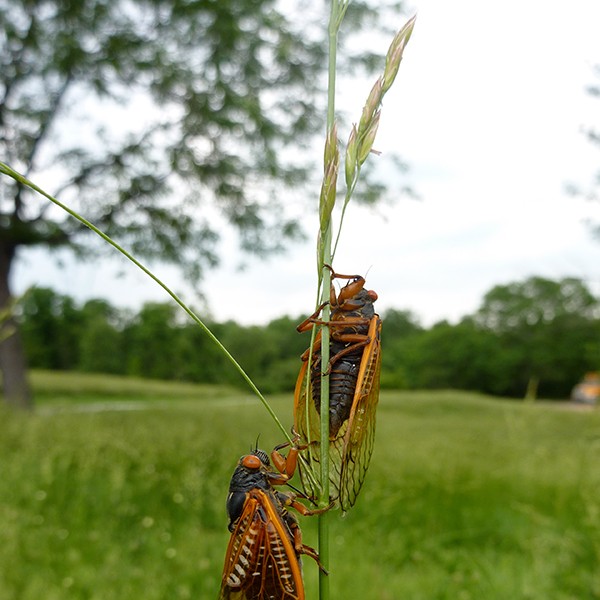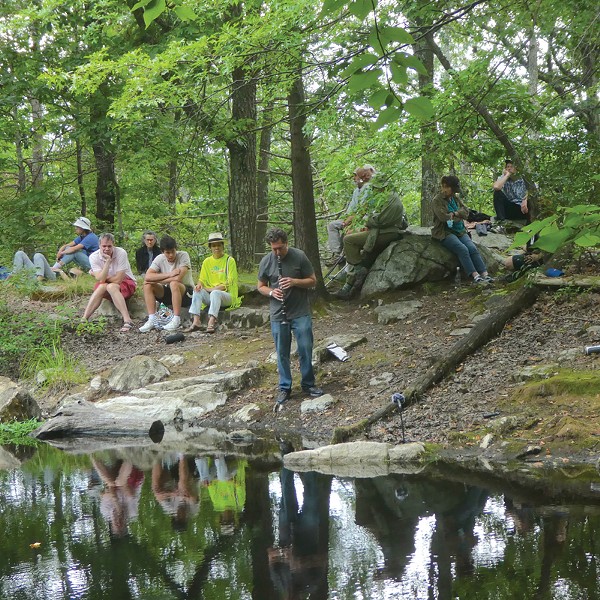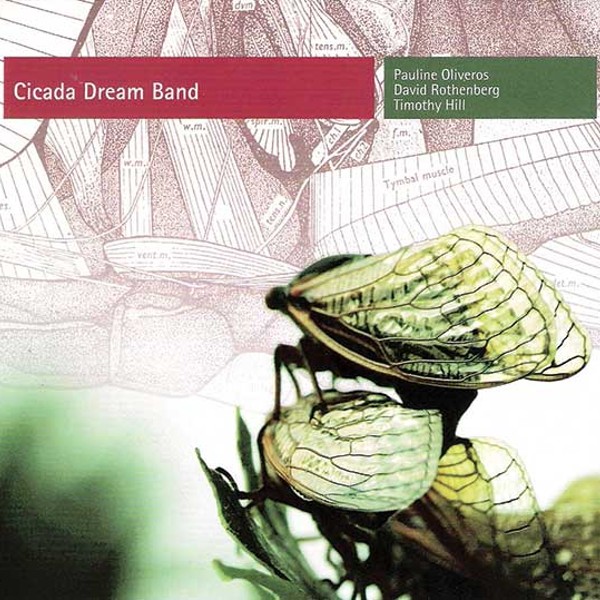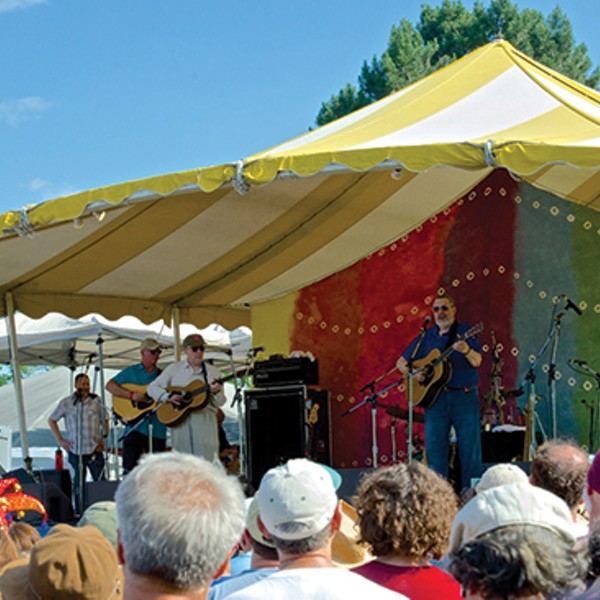When did people first notice the prime numbered cycles of cicadas, something that only happens in North America? Certainly the early Pilgrims experienced an emergence a few years after landing at Plymouth Rock. William Bradford wrote in 1633, "all the month of May, there was such a quantity of a great sort of flyes like for bigness to wasps or bumblebees, which came out of holes in the ground and replenished all the woods, and ate the green things, and made such a constant yelling noise as made all the woods ring of them, and ready to deaf the hearers."
Naturalist Paul Dudley was the first to study the emergence in detail. His research took a very long time to get going. He incorrectly called them locusts, and first observed them in 1699, then again in 1716, but he waited until 1733 to make sure they really were emerging every 17 years, when he submitted his results to the Royal Society in London. "They are in great numbers in our woods, the noise is loud to the degree that our farmers have not been able to hear their cowbells tho in sight. I have myself been traveling thro the midst of thousands of them, and the noise was such that there was no conversing for some miles together, & it carried even some terror with it." This agrees with the Prophet Joel when he alludes to the noise made by this animal: "As the noise of the chariots upon the tops of mountains shall they leap, like the noise of a flame of fire."
I believe people actually like the sound of all this white noise in the forest. It is like begging to listen to the call of the ocean in a conch shell, or the repeating peal of waves on the shore, or even the pleasing flow of traffic on the highway below the city window. We have long appreciated the washes of pitchless rhythms crashing in from this noisy world. And now more than ever we can praise the musical value of noise as never so much loved before.
By the late 19th century, scientists had finalized the list of the various "broods" of periodical cicada that come out at very definite times over 17-and 13-year intervals, in very specific locations only in the Eastern United States. They named them Magicicada in Latin to celebrate their wondrously strange life cycle. Nowhere else in the world has evolution organized such a pattern of vast cicada emergences. There were originally 14 17-year broods, numbered I to XIV. Today, brood XII is extinct. There were four 13-year broods, numbered XIX to XXIII. Today, brood XX is extinct. The most extensive broods are II, X, XIV, and XIX, which will emerge in 2013, 2021, 2025, and 2024, respectively.
A lavish two page illustrated spread by Donald Prattie from a 1936 issue of the New York Times maintains that the periodical cicada is "still the most misunderstood insect on our continent." He reminds us, as the newspapers always seem to do every 13 or 17 years, that these cicadas are not locusts, they do not eat crops, they do not sting babies to death, and they will not harm your fruit trees excessively. He urges us to respect the cicada, to think of all the dangers it must face in its short, few weeks of life above ground, being chased by birds, eaten by dogs, cats, and foxes, struggling to have a chance to mate and get the most out of their brief time singing and breathing in air. Prattie was no fan, though, of the sound: "To me the din is one of the most depressing and unnerving ever heard, not only because of its monotony but because of its suggestion that something terrible is going to happen."
Something terrible? Just wait a few weeks. One day, all of a sudden, the sound will stop, and we will have 17 more years of Magicicada silence. It is a humbling thought, with a touch of the sublime. The great entomologist H. A. Allard had this to say after the emergence of Brood XIX in eastern Virginia in 1920: "I felt a positive sadness when I realized that the great visitation was over, and there was silence in the world again, and all were dead that had so recently lived and filled the world with noise and movement. It was almost a painful silence, and I could not but feel that I had lived to witness one of the great events of existence, comparable to the occurrence of a notable eclipse or the visitation of a great comet." I get the sense Allard is not far from the view of the Maori, who tend to speak of their native Aotearoa / New Zealand cicadas as "the insect people." In a well-known chant first written down in 1853 they speak of what it means to connect to these other beings:
Ki ouru
Ki owhawha
Kia kata noa mair to Kikitara
To join
To feel
The cicada's cry
All of us who have tried to make sense of this awesome sonic phenomenon have wanted to find a way inside the sound, to become part of it or make it a part of us. I myself have enjoyed playing music with them, live and in the studio, as revealed in my new book and CD Bug Music. I went from birds, to whales, and now to bugs. In a way they are the most surrounding, and transforming. The raw thrum beating inside our heads and in our past since long before our kind was born.
And yet it is so hard to remember, so many years in between these emergences, to know what it means to live deep inside of such noise. To know it, not to fear it. To feel the wonder at a natural phenomenon that is so present, yet so rare.
Honestly, we really have no idea why these insects come out when they do, why they have such a great inscrutable rhythm that emerges rarely but precisely over the years. I try my best to conceive it as a vast natural rhythm, whose downbeat I can barely remember. It was there when I was born, in 1962. Then I had a pale glimmer of awareness of it in 1979, when I was just starting to care about music in nature. Then in 1996 it swirled around me at my first home in the Hudson Valley and prevented me from thinking about anything else. Then I began to think that by the next round I would write a book about it, since no one had thought of this whole slow measure as music ever before. Now we're here: 2013. Enjoy the emergent cicada symphony while you can. Imprint it in your memory so its wonder will always be there. Seventeen years from now, you will be prepared.
This article is an excerpt from Bug Music: How Insects Gave Us Rhythm and Noise (St Martins Press, 2013).
Cicada Events
June 5
Nature Week at Mohonk Mountain House in New Paltz begins, featuring a special cicada concert at 9 pm with David Rothenberg, Pauline Oliveros, Mikhail Horowitz, overtone singer Timothy Hill, and a cicada invocation by Ione.
June 9
David Rothenberg reads from Bug Music at Hudson Valley Outfitters in Cold Spring at 4 pm.
June 14
An opening reception of a cicada-related art show with spoken word and acoustic music tributes to the cicadas, curated by Mikhail Horowitz, from 5 to 8 pm. Donskoj & Company, Kingston.
June 15
Cicada Celebration and outdoor concert from 3 to 6pm featuring performances by Pauline Oliveros, Ione, David Rothenberg and musicians, Mikhail Horowitz and Gilles Malkine, Tony Levin, The Princes of Serendip (T. G. Vanini and Julie Parisi), Ryan Ross Smith and Torben Pastore, naturalist Spider Barbour, Leaf Miller, and others. Rotary Park, Kingston.
June 16
Guided visit to Eve’s Point in Saugerties with naturalists Spider and Anita Barbour from 1 to 3pm.







